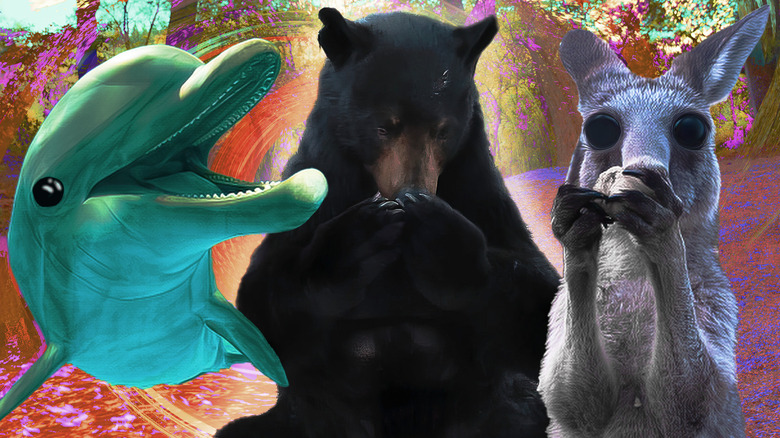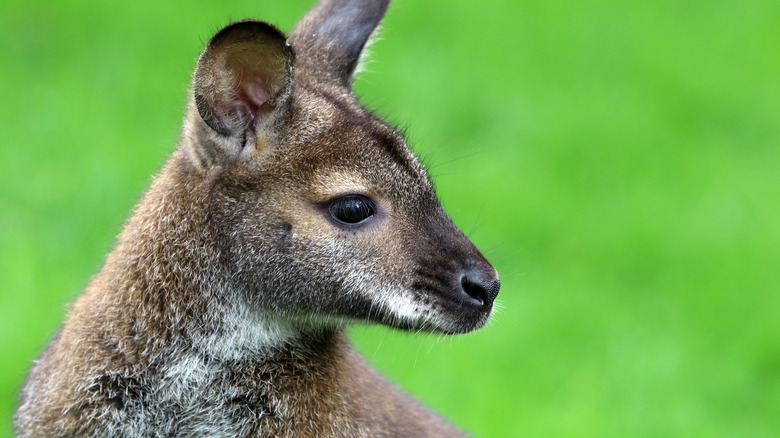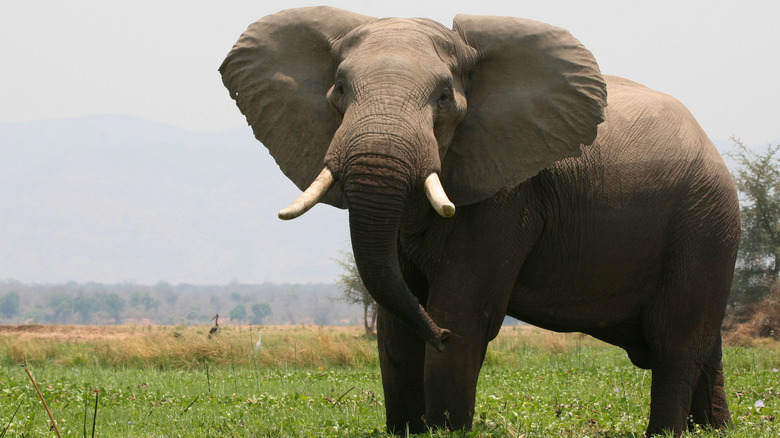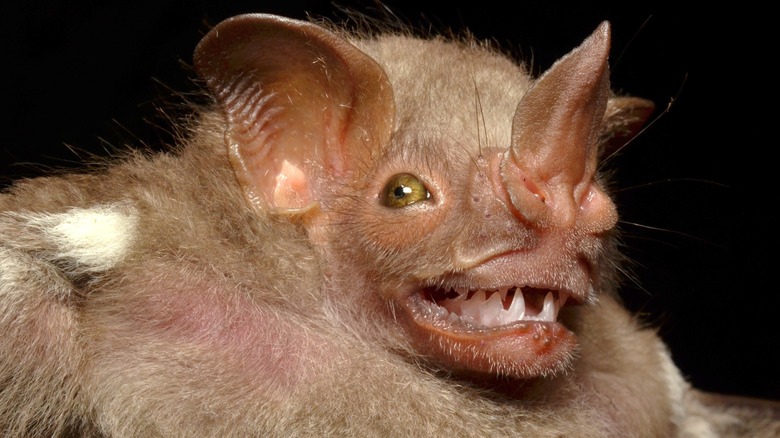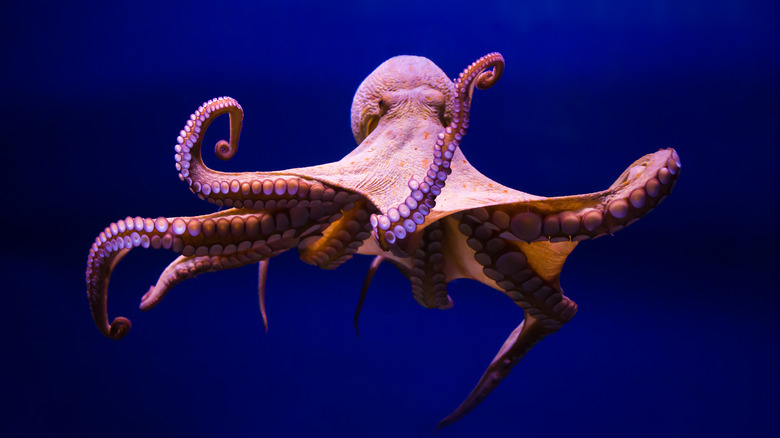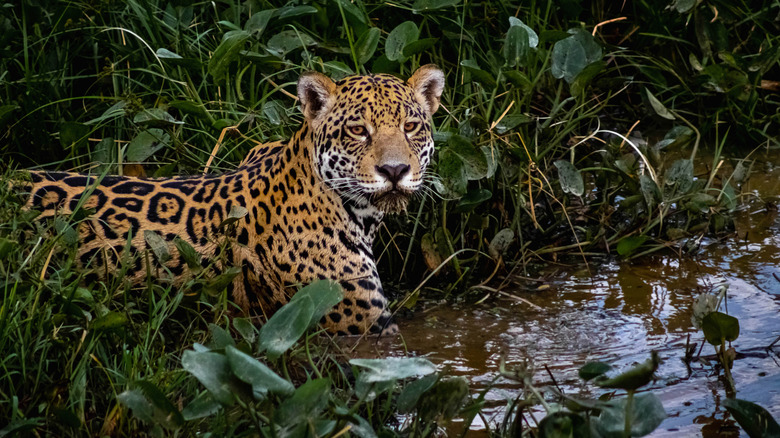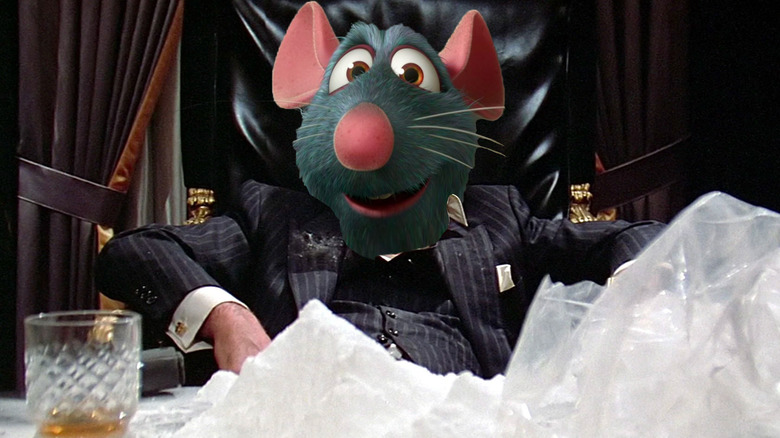After Cocaine Bear, These True Stories Of Animals On Drugs Need To Be Told
Imagine, if you will, a world where a bear does cocaine. Transport yourself to a universe, a different reality, a "Sliders" timeline of sorts, where an apex predator weighing anywhere from 250 to 600 pounds ingests a ton of one specific stimulant that directly affects its central nervous system. Fantasize about what might happen if one of the world's most dangerous and lethal animals did a ton of a drug that makes you agitated, amorous, and just weirdly amped about life. Concoct an image in your brain about a grizzly bear living its life and minding its own business until it stumbles across the motherlode, meaning "a ton of cocaine."
If you can paint this crazy picture for yourself, then you're probably the exact right audience for "Cocaine Bear." Brought to you by actor-director Elizabeth Banks and a weirdly stacked cast that includes half of the roster from "The Americans," "Cocaine Bear" tells the inexplicably true story of the time a bear got into a ton of cocaine (like when Winnie the Pooh gets into a honey pot, but way, way weirder). All of this got the Looper staff thinking — what animal-on-drugs chicanery based on real, actual stories do they want to see grace the big screen after "Cocaine Bear?"
Nina Starner - If you love cocaine bears, prepare yourself for opium wallabies
Doing research for this article was pretty wild, let me tell you. My Google search algorithm is all doinked up now. I don't know if "animals doing drugs" sets off any specific alarms for whatever force babysits the Internet, but, whatever. Over here at Looper, we do what must be done for the greater good.
Anyway, when I did that Google, I found out that, back in 2009, when Obama was still President and we didn't know what a COVID was, wallabies in Tasmania got pretty silly off of opium. That's right. Opium. So how did these marsupials even get access to a drug like this without even knowing anyone from the Sackler family? As it happens, poppy fields were getting swarmed by wallabies over on the isle of Tasmania. Said wallabies would promptly get very high off of not-their-supply and then — wait for it — wander around and make accidental crop circles. That's right. Not only were these wallabies pulling a full "Elaine Benes tests positive for opium because of muffins" from "Seinfeld," but they were also keeping conspiracy theorists in business by making inadvertent crop circles.
Go ahead and tell me this isn't box office gold. Prove to me that this isn't M. Night Shyamalan's next project because this twist is, let's face it, a hell of a lot better than anything that happens in "The Happening." Tell me you don't want to see Toni Collette use her natural Australian accent to play a farmer mystified by the crop circles in her poppy fields. If nothing else, consider this project a spiritual sequel to "Kangaroo Jack," where we find out that maybe Jack hasn't been doing so hot since we last checked in with him. Write me a check, Hollywood. I've just handed you your next big hit.
Tom Meisfjord - My dog got into some gummies one time
So I'm headed into the kitchen to grab some cold ham when I notice a couple of empty candy wrappers lying on the ground. I'm a tidy gentleman, not prone to chucking detritus on my floors, and I live alone. Needless to say, I'm curious. Meanwhile, my dog has gone mysteriously silent, and I spot him avoiding eye contact under the desk.
Now me? I'm lucky. I live in a corner of this more perfect union where you can legally walk into a strip mall and say "I'd like one medically-induced coma, please" and the next thing you know, someone's handing you what's basically a Starburst that makes it fun to watch "The Mighty Boosh." It just so happened that I'd left a couple of whatnots in a box on my bedside table, which my dog had managed to open while I was in the shower. He was solving puzzles to get high, like a velociraptor lashing out the summer of its parents' divorce.
Look, it might not sound like a dramatic, Hollywood-ready yarn I'm spinning, but I'd encourage you to look up "what happens if your dog eats weed?" For all of the incendiary, fear-based medical rhetoric that you find on WebMD, it's nothing compared to the Greek chorus of portents of doom that come screaming out of your smartphone when you ask about pet health. I was reading whole paragraphs about how marijuana kills dogs, thinking "who wrote this? Dog Nancy Reagan?"
Anyway, I called the vet and told him what happened and he said to get my dog a big bowl of water and put on "In The Aeroplane Over the Sea." I wrapped him in a blanket burrito and gave him some cold ham and he slept for 12 hours like he was on a rocket ship to Alpha Centauri.
In retrospect, maybe this wouldn't be a good movie.
Melissa Lemieux - An elephant on acid, anyone?
"Cocaine Bear," make way — we have an elephant on acid to deal with!
Unlike the titular cocaine bear's tragedy, this elephant dealt with a manmade high that they didn't stumble upon in the wild. Apparently, its bad trip was a result of a zoo director who conducted an experiment on the elephant, whose name was Tusko. In 1962, Warren Thomas, then working as director of Lincoln Park Zoo in Oklahoma City, darted 300 milligrams of LSD into Tusko to determine how much acid it takes to cause an elephant to go into "musth" — a sort of aggressive behavior unto temporary madness displayed by male elephants. That's 3000 times the size of a typical human hit.
The experiment – conducted as part of a study in musth undertaken by then-University of Oklahoma research scientists Louis Joylon West (later famous for his experiments into the limits of human endurance) and Chester M. Pierce — didn't end well for poor Tusko. He ran around his pen trumpeting for awhile, and then collapsed and died after being injected with Thorazine in an attempt at "bringing down" his high. The hypothesis proven was, apparently, that elephants are apparently very sensitive to LSD. Thomas himself would resign from the zoo in 1964and go on to work at multiple other faculties, where accusations of animal mistreatment and mishandling of city funds would dog him.
One could imagine a dramatic Ahab-like drama centered around Thomas' scientific obsession, or perhaps even a taut courtroom drama evolving out of such a story. Who would play Thomas? Perhaps Willem Dafoe or Nicolas Cage would have the right combination of brio and over-the-top acting style to portray a man tasked with caring for animals who harms one to prove a theory. Throw in Margot Robbie as his wife Marilyn, and you have a film.
Pauli Poisuo - Drunk bats must infiltrate every genre
The everyday life of a bat carries a moderate-to-high chance of munching on fermented fruit, which effectively turns its meal into a five-martini lunch served in one convenient package. Not only does this explain a whole lot about bats to anyone who's ever tried to chase one out of their living room, but an army of drunken bats is a concept that opens an array of cinematic possibilities.
A horror-slash-disaster movie about a rowdy horde of what amounts to plastered flying gremlins is the first thing that comes to mind, but why stop there? "Drunk bats" can and absolutely should be applied to any and all bat-adjacent concepts. A colony of vampire bats set loose on St. Patrick's Day? Approved! Nic Cage in full Dracula regalia, haunting the streets after the bars close? Might be happening somewhere already, someone just needs to film it! A group of extremely hungover bats waking up around a fruit tray in Vegas, trying to figure out why there's a tiger in the bathroom? Greenlit by the time it took to type that sentence! Hammered Chiroptera, Hollywood. It's a license to print money.
In the interest of full disclosure, I'm introducing this idea with a very specific movie in mind — one that we can't get until bats' penchant for drunkenness becomes a commonly accepted and expected pop culture attribute. Picture a young, recently orphaned billionaire stumbling into a cave full of absolutely tanked megabats, and getting an idea. Fast forward a decade to a moonlit rooftop. "I'm — hic – Batman," the man in vodka-stained bondage gear exclaims before he glides down to attack the mugger in the alley, trips on his cape, and starts gently snoring in the gutter. Roll credits.
Rick Stevenson - Let's give party drugs to cephalopods
Ever wondered what would happen if you gave an octopus MDMA? If so, you might be an actual, honest-to-God scientist. No, I'm not joking. Some researchers dedicate their studies to boring old titrations, while the Chad scientists give party drugs to cephalopods.
In 2018, Johns Hopkins neuroscientist Gül Dölen and marine biologist Eric Edsinger sent a select few octopuses absolutely rolling. The purpose? Measuring the effects of MDMA — also known as Molly or Ecstasy in less lab-controlled environments — on the social function of the animals. The result? Octopuses given the drug became significantly less solitary and more cuddly with their nearby brethren, demonstrating similarities between their brains' social functions and our own. The only things missing were a little dubstep and enough glowsticks for all of their tentacles.
I know that science experiments might lack the conflict and drama demanded on the silver screen, but that's where movie magic and a little imagination come in. Imagine this: a fleet of E'd-up octopus buds breaking out of captivity to throw the rager of the century. We already know that the creatures are capable of making these kinds of escapes. Just imagine what they could do as one with the power of trip-induced free love on their side. Plus, with recent hits like Netflix's "My Octopus Teacher," there's clearly an audience primed and ready for more octo-content.
Animation seems like the best venue for such a tale, though Jim Cameron's extensive explorations into undersea filmmaking and CGI are also promising. In fact, some actual scientists have posited that the Octopus could be an alien creature. "Avatar: The Way of Water?" Try "Octopus: The Rave of Ages." Alternatively, we could just ask the creatures themselves for some story ideas. After all, they do have nine brains.
Kieran Fisher - Forget about Simba, big cat movies need more jaguars on DMT
When it comes to movies about wildcats, lions and tigers receive most of the attention. Granted, they're both majestic creatures that command respect wherever they go, but they aren't hedonistic cats like the jaguars of the Amazon rainforest who like to get buzzed.
Jaguars are the third-largest cat species on the planet, making them a force to be reckoned with. They're fierce hunters who prey on everything from tortoises to monkeys. However, some of them are fond of plant-based substances, especially the leaves of the yagé vine, which contain the hallucinogenic components associated with the narcotic known as DMT. The leaves have been known to have a trippy effect on the spotty predators, as evidenced by the BBC's "Weird Nature" documentary and several clips on YouTube. Enter at your own risk.
For those of you who aren't familiar with the effects of DMT, it basically distorts reality. The drug possesses immersive qualities that make people feel at one with themselves and the universe; sometimes they're transported to other dimensions. When it's good, DMT expands the imagination and inspires moments of soul-enriching introspection, so it's a crime that no filmmaker has made an arthouse movie about a spaced-out jaguar embarking on an interdimensional voyage of self-discovery.
A DMT jaguar movie writes itself. The dialogue could include phrases like "I'm feline good, baby" and "purrfect" during the euphoric moments. Of course, there are some disturbing side effects associated with DMT too, with reports ranging from people having near-death experiences to interacting with creepy clockwork elves throughout their trips. That's no laughing matter, but the best movies about drug-induced self-discovery contain moments of beauty and horror. The light at the end of the tunnel always shines brighter following a period of immense darkness. DMT jaguar movies should be no different.
Mike Bedard - Reindeer on magic mushrooms is the greatest Christmas movie never told
Thanks to HBO's "The Last of Us," mushrooms are having a bit of a moment right now. Of course, fungi can do so much more than burrow into your brain and turn you into a ravenous zombie. Certain varieties can also make you hallucinate, feel euphoric, and gain a greater appreciation of EDM.
As such, it makes sense that humans aren't the only ones who take advantage of the chill vibes. Many animals, but particularly reindeer, have been known to consume mushrooms that make them act all loopy. Specifically, reindeer are big fans of the fly agaric mushroom, which can be toxic to humans, but they can eat it to their heart's content, making them behave drunkenly and make weird noises. In fact, some scholars believe the connection between reindeer and mushrooms led to the myth of Santa's flying reindeer. While speaking with NPR, biology professor Donald Pfister spoke about a book from R. Gordon Wasson who notes how shamans in Siberia would consume mushrooms for their hallucinogenic properties. Reindeer would eat them, too, so the theory goes that the shamans believed reindeer acting erratically were flying, adding to the mythos of Santa.
There's no way to definitively prove that's where the myth came from, but the idea could make for a hilarious adult animated comedy in the vein of "Sausage Party." Just think of a Christmas movie where all of Santa's reindeer have to get super high in order to pull the sleigh. All you have to do is cast Seth Rogen as Rudolph and you're off to the (reindeer) races. Plus, it could help normalize psychedelic use during a time when medical professionals are experimenting with mushrooms in therapies to help with PTSD and depression. A stupid movie could do a lot of good, like how the world got introduced to Charlize Theron in "Children of the Corn III: Urban Harvest."
Russell Murray -- A scientist wanted dolphins to speak English, so he gave them LSD
In the 1960s, a few scientists (including famed astronomer Carl Sagan) became obsessed with a bizarre hypothetical. What if dolphins — with their abnormally large brain mass — could communicate with humans?
This theory was pioneered by, ahem, "eccentric" neuroscientist John Lilly, who authored the highly controversial and semi-speculative book "Man and Dolphin." Upon becoming familiar with his work, interested parties at NASA secured Lilly a blank check to run linguistic experiments on the animals at a marine laboratory on St. Thomas island. The end goal was to learn how to speak "dolphinese" so that they can eventually learn how to speak alien (there may be a few missing steps between Point A and Point B, but godspeed anyway, NASA). Clearly, there's already a lot to unpack here — and that's before adding in the sex and drugs.
You see, there was a young woman on St. Thomas named Margaret Lovatt whose life's goal was to communicate with dolphins, and after strolling up unannounced to the lab, Lilly made her a key component of their experiments. Sound judgment all around. Determined to spend every waking moment in the lab, Lovatt lived there with three dolphins — including a male named Peter. One thing led to another, and some supposedly necessary but definitely NSFW events went on in the tank, attracting the attention of several publications including Hustler.
Dissatisfied with their slow progress, Lilly — allegedly rolling out of his gourd — had the bright idea to give all of the dolphins LSD (except Peter, at Lovatt's request). Big surprise! It had absolutely no effect on their ability to understand each other — especially because instead of studying how dolphins communicate, Lilly personally elected to teach them English. Long story short, NASA saw little scientific value in continuing to fund the deranged (and occasionally "sensual") happenings on St. Thomas, and funding was quickly pulled. Peter — apparently heartbroken by his separation from Lovatt — stopped breathing soon after.
If Hollywood can't turn this story into a blockbuster hit, we all need to pack up and go home.
Nick Staniforth - You've heard of Cocaine Bear, so let's try Cocaine Rats (who love jazz)
Picture the pixelated scene. Remember the charm of "Ratatouille" and the incredible soundtrack of "Soul?" What if those outstanding elements were cut together and snorted up by CGI critters in Pixar's first adult-themed animation, "Jazz Rats!" Based on a real-life study from 2011 at the Albany Medical College (via Classical FM)? Initially put into action to see if it could stimulate drug cravings in animals from music, the little critters were forced to listen to Beethoven's "Für Elise" and Miles Davis' "Four." While the study revealed that they preferred silence more than anything, Beethoven got a more significant approval rating than Miles Davis — until drugs were thrown into the mix.
For the rats that didn't bust much of a move when Miles was played, 10mg of cocaine was provided. Surprising no one, they gradually became Miles Davis fans the more goods they got given. Okay, the experiment may not have yielded insightful results, but it would undoubtedly fit the "inspired by a true story" criteria for a film that could take a few liberties. Imagine a young scientist befriending one of the rats that was given cocaine, only for said rat to wind up in a drug war over the dispensed goods in a "Scarface" style gangster movie, with one rat left standing, all to the smooth sounds of Miles Davis. Go on, Pixar. Push it to the limit.
If you or anyone you know needs help with addiction issues, help is available. Visit the Substance Abuse and Mental Health Services Administration website or contact SAMHSA's National Helpline at 1-800-662-HELP (4357).
